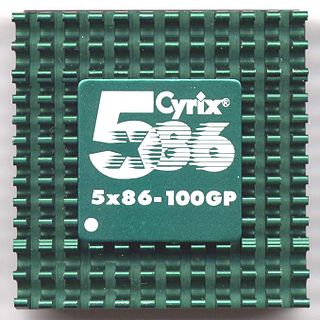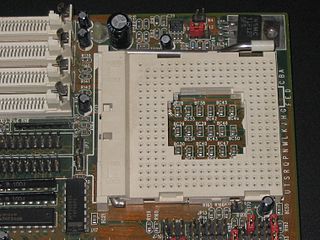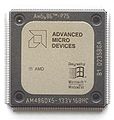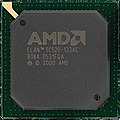
Athlon is the brand name applied to a series of x86-compatible microprocessors designed and manufactured by AMD. The original Athlon was the first seventh-generation x86 processor and the first desktop processor to reach speeds of one gigahertz (GHz). It made its debut as AMD's high-end processor brand on June 23, 1999. Over the years AMD has used the Athlon name with the 64-bit Athlon 64 architecture, the Athlon II, and Accelerated Processing Unit (APU) chips targeting the Socket AM1 desktop SoC architecture, and Socket AM4 Zen microarchitecture. The modern Zen-based Athlon with a Radeon Graphics processor was introduced in 2019 as AMD's highest-performance entry-level processor.

The Cyrix 6x86 is a line of sixth-generation, 32-bit x86 microprocessors designed and released by Cyrix in 1995. Cyrix, being a fabless company, had the chips manufactured by IBM and SGS-Thomson. The 6x86 was made as a direct competitor to Intel's Pentium microprocessor line, and was pin compatible. During the 6x86's development, the majority of applications performed almost entirely integer operations. The designers foresaw that future applications would most likely maintain this instruction focus. So, to optimize the chip's performance for what they believed to be the most likely application of the CPU, the integer execution resources received most of the transistor budget. This would later prove to be a strategic mistake, as the popularity of the P5 Pentium caused many software developers to hand-optimize code in assembly language, to take advantage of the P5 Pentium's tightly pipelined and lower latency FPU. For example, the highly anticipated first-person shooter Quake used highly optimized assembly code designed almost entirely around the P5 Pentium's FPU. As a result, the P5 Pentium significantly outperformed other CPUs in the game.

The Intel 386, originally released as 80386 and later renamed i386, is a 32-bit microprocessor introduced in 1985. The first versions had 275,000 transistors and were the CPU of many workstations and high-end personal computers of the time. As the original implementation of the 32-bit extension of the 80286 architecture, the i386 instruction set, programming model, and binary encodings are still the common denominator for all 32-bit x86 processors, which is termed the i386 architecture, x86, or IA-32, depending on context.

The Intel 486, officially named i486 and also known as 80486, is a microprocessor. It is a higher-performance follow-up to the Intel 386. The i486 was introduced in 1989. It represents the fourth generation of binary compatible CPUs following the 8086 of 1978, the Intel 80286 of 1982, and 1985's i386.

The K6 microprocessor was launched by AMD in 1997. The main advantage of this particular microprocessor is that it was designed to fit into existing desktop designs for Pentium-branded CPUs. It was marketed as a product that could perform as well as its Intel Pentium II equivalent but at a significantly lower price. The K6 had a considerable impact on the PC market and presented Intel with serious competition.

The Pentium is a fifth generation, 32-bit x86 microprocessor that was introduced by Intel on March 22, 1993, as the very first CPU in the Pentium brand. It was instruction set compatible with the 80486 but was a new and very different microarchitecture design from previous iterations. The P5 Pentium was the first superscalar x86 microarchitecture and the world's first superscalar microprocessor to be in mass production—meaning it generally executes at least 2 instructions per clock mainly because of a design-first dual integer pipeline design previously thought impossible to implement on a CISC microarchitecture. Additional features include a faster floating-point unit, wider data bus, separate code and data caches, and many other techniques and features to enhance performance and support security, encryption, and multiprocessing, for workstations and servers when compared to the next best previous industry standard processor implementation before it, the Intel 80486.

Cyrix Corporation was a microprocessor developer that was founded in 1988 in Richardson, Texas, as a specialist supplier of floating point units for 286 and 386 microprocessors. The company was founded by Tom Brightman and Jerry Rogers.

The Cyrix 5x86 was a line of x86 microprocessors designed by Cyrix and released on June 5 of 1995. Cyrix, being a fabless company, had the chips manufactured by IBM. The line came out about 5 months before the more famous Cyrix 6x86. The Cyrix 5x86 was one of the fastest CPUs ever produced for Socket 3 computer systems. With better performance in most applications than an Intel Pentium processor at 75 MHz, the Cyrix Cx5x86 filled a gap by providing a medium-performance processor option for 486 Socket 3 motherboards.
The Pentium OverDrive was a microprocessor marketing brand name used by Intel, to cover a variety of consumer upgrade products sold in the mid-1990s. It was originally released for 486 motherboards, and later some Pentium sockets. Intel dropped the brand, as it failed to appeal to corporate buyers, and discouraged new system sales.

The Am486 is a 80486-class family of computer processors that was produced by AMD in the 1990s. Intel beat AMD to market by nearly four years, but AMD priced its 40 MHz 486 at or below Intel's price for a 33 MHz chip, offering about 20% better performance for the same price.
NexGen, Inc. was a private semiconductor company based in Milpitas, California, that designed x86 microprocessors until it was purchased by AMD in 1996. NexGen was a fabless design house that designed its chips but relied on other companies for production. NexGen's chips were produced by IBM's Microelectronics division in Burlington, Vermont alongside PowerPC and DRAM parts.

The K5 is AMD's first x86 processor to be developed entirely in-house. Introduced in March 1996, its primary competition was Intel's Pentium microprocessor. The K5 was an ambitious design, closer to a Pentium Pro than a Pentium regarding technical solutions and internal architecture. However, the final product was closer to the Pentium regarding performance, although faster clock-for-clock compared to the Pentium.

The Cyrix Cx486DLC is an x86 desktop microprocessor developed by Cyrix. It was Cyrix's second CPU offering, released years after selling math coprocessors that competed with Intel's units and offered better performance at a comparable or lower price. It was released in June of 1992, with a price of $119 for computer manufacturers.

Socket 3 was a series of CPU sockets for various x86 microprocessors. It was sometimes found alongside a secondary socket designed for a math coprocessor chip, such as the 487. Socket 3 resulted from Intel's creation of lower voltage microprocessors. An upgrade to Socket 2, it rearranged the pin layout. Socket 3 is compatible with 168-pin socket CPUs.

Geode was a series of x86-compatible system-on-a-chip (SoC) microprocessors and I/O companions produced by AMD, targeted at the embedded computing market.

A compatibility card is an expansion card for computers that allows it to have hardware emulation with another device. While compatibility cards date back at least to the Apple II family, the majority of them were made for 16-bit computers, often to maintain compatibility with the IBM PC. The most popular of these were for Macintosh systems that allowed them to emulate Windows PCs via NuBus or PCI; Apple had released several such cards themselves.

The Cyrix Cx486 was an x86 microprocessor designed by Cyrix. It primarily competed with the Intel 486 with which it was software compatible, would operate in the same motherboards provided proper support by the BIOS was available and generally showed comparable performance. The chip also competed with parts from AMD and UMC.

The IBM ThinkPad 365 is a notebook computer series developed by IBM and manufactured by ASE Group. It was released in North America in November 1995, and was the successor of the ThinkPad 360 series. The series had 8 models that were released before being discontinued, and was succeeded in 1997 by the ThinkPad 380 series.

AMD Élan is a family of 32-Bit embedded SoCs marketed by AMD based on x86 microprocessors. All of these products have been backed with a long-term supply guarantee to meet the needs of embedded processors. However, when AMD acquired the Geode division from National Semiconductor in August 2003, the product was suddenly discontinued. The Élan processors have certainly provided some momentum in the embedded world.






















